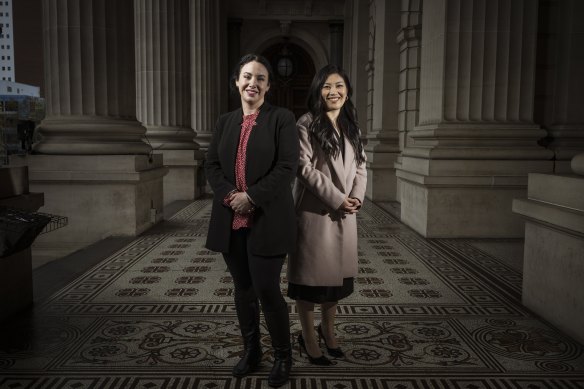More than half of Labor Party candidates at the Victorian election will be women, while just over a third of would-be Liberal MPs will be female after internal debate in the party about the role of quotas.
The ALP has preselected 45 women for the lower house ahead of November’s state poll. With the party yet to preselect candidates for 12 seats, women already make up 51 per cent of Labor hopefuls for the 88-seat chamber.
Emma Vulin (ALP, Pakenham) and Nicole Ta-Ei Werner (Liberal, Box Hill) are among the women standing in the November’s poll.Credit:Chris Hopkins
At the 2018 election, Labor fielded 41 women candidates for the lower house.
The Liberals have so far announced that 22 women will be standing in the lower house, just over one-third of all candidates announced so far. Four years ago, the party had 24 women standing for lower house seats.
Labor insiders pinpoint the introduction of quotas for women running in winnable seats in the mid-1990s, and a target set in 2015 for half of elected representatives to be women by 2025, as the foundation for the rise in numbers.
“The decision to introduce quotas is exactly what has meant that we have the number of women we have running today,” said Pamela Anderson, chief executive of Labor-aligned women’s advocacy group Emily’s List.
Emma Vulin, the ALP candidate for Pakenham in Melbourne’s east, said it was women including her mother, who was an electoral officer, and women currently serving as ministers who had paved the way.
“I knew it wasn’t impossible, and I knew it was harder for a woman. But I think our party is catching up now,” said Vulin who was also an electoral officer for federal and state MPs including Premier Daniel Andrews.
Nicole Werner, the Liberal candidate for the seat of Box Hill, said she has chosen to enter politics after a career in the non-profit sector to represent communities who were impacted during COVID-19 lockdowns. She said politics needed a greater spread of women, and people of diverse ethnic backgrounds and ages.
“That wasn’t the driving force of why I chose to go into politics, but that was something I had in the back of my mind,” Werner said.
The Liberals did not follow through on a push to introduce gender quotas for candidates last year, despite Opposition Leader Matthew Guy and then-prime minister Scott Morrison backing moves to increase female representation.
Werner, who was selected on merit over four men, said she did not support quotas, pointing to her own candidacy as an example of women’s ability to succeed.
“It is a meritocracy. And I know that to be the case for myself … I think we are progressing even without [quotas],” she said.
“You can’t be what you don’t see. And so I think by going into politics as a young woman is already changing the game.”
The Nationals have seven women and seven men standing at the coming election, with two fewer men standing than in 2018 responsible for evening the gender balance.
“It’s about getting the most appropriate and best candidates in the field; we are not picking people just because of their gender,” Nationals state director Matthew Harris said.
The Greens have preselected 55 candidates, more than half of them women. A spokesman said the party was on track to preselect more women candidates than ever before.
There were 887 candidates at the last election across both houses, and the Victorian Electoral Commission expects a similar number of candidates will nominate this election.
The Morning Edition newsletter is our guide to the day’s most important and interesting stories, analysis and insights. Sign up here.
Most Viewed in Politics
From our partners
Source: Read Full Article

